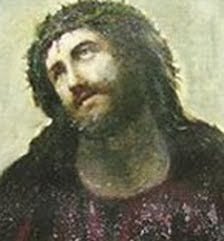The road to hell is paved with good intentions.
Surely the eighty year old Cecilia Giménez meant well when she took it upon herself to restore a church fresco that had fallen into disrepair. But after being lambasted by local officials and family members of the late artist, and threatened with legal action, I guess she's feeling a little unappreciated. So now she'd like to be paid for her trouble. She'll settle for a cut of the church's proceeds now that her masterpiece has put the little town of Borja on the map.
The before and after pictures went viral across the globe and tourists began arriving in droves -- but very few were leaving donations according to Ars Technica. The sanctuary's owners, the Santi Spiritus Hospital Foundation, reportedly made $2,600 in four days from visitors wanting to see "Ecce Mono," or "Behold the Monkey" as it's now called, Ars Technica reported.
Both sides have retained counsel, with the Santuario de Misericordia church scrambling to protect its assets. They will need whatever they've been able to take in to pay a real art restorer. That is, if they can find one capable of undoing the damage from Giménez's act of artistic largesse. The jury is still out as to whether or not it can be restored to its original state.
That said, 18,000 people have signed a petition to leave the Giménez version as it is. Said one woman, "The previous painting was also very pretty, but I really like this one."
Perhaps they see something in Giménez's work that others don't. Art-Eater.com posits that the octogenarian's work is a rich commentary on the inner conflicts of faith in a modern world.
By creating the work as what some might call an act of vandalism, Gimenez combines the subversive spirit of graffiti street-culture with the reverence of religious tradition, reminding us of the revolutionary nature of Christianity, a faith that was outlawed in its early days.
The unconventional nature of the restored painting tells a story. The fringes of the painting are very faithful to the original, particularly in the cloth. However, the painting becomes looser, more expressionistic as we move to the center. This is reflective of how modern people have grown comfortable with the superficial window dressings of Christianity, yet tensions secretly boil at the core. The original painting depicts Christ’s moment of doubt on the cross, as described in PSalm 22, where he wonders “My God, my God, why have you forsaken me?”
. . .
By depicting Christ with simian features, the piece smolders with the passion and agony of contemporary man, struggling to reconcile religion and science. Are we the divine children of god or the discordant descendants of apes? The lingering power of this question has lead contemporary worshipers to redub the fresco “Ecce Mono” or “Behold The Monkey.”
The painting daringly trails off at the mouth of Christ, left unfinished, imploring us to come to our own conclusion. Though the words of the bible are to be venerated as the word of God, the final sermon has yet to be delivered. Though icons are beautiful expressions of faith, the real substance of Christianity is found in a personal communion with God, a cornerstone of Catholicism.
They've also posted some pretty pictures of her future restorations.
Other critics have not been as kind.
Giménez's efforts have been variously been dubbed "the worst restoration in history", "a botched job", and "a crayon sketch of a very hairy monkey in an ill-fitting tunic".
What no critic seems to have noticed is the elements of self portraiture.






No comments:
Post a Comment